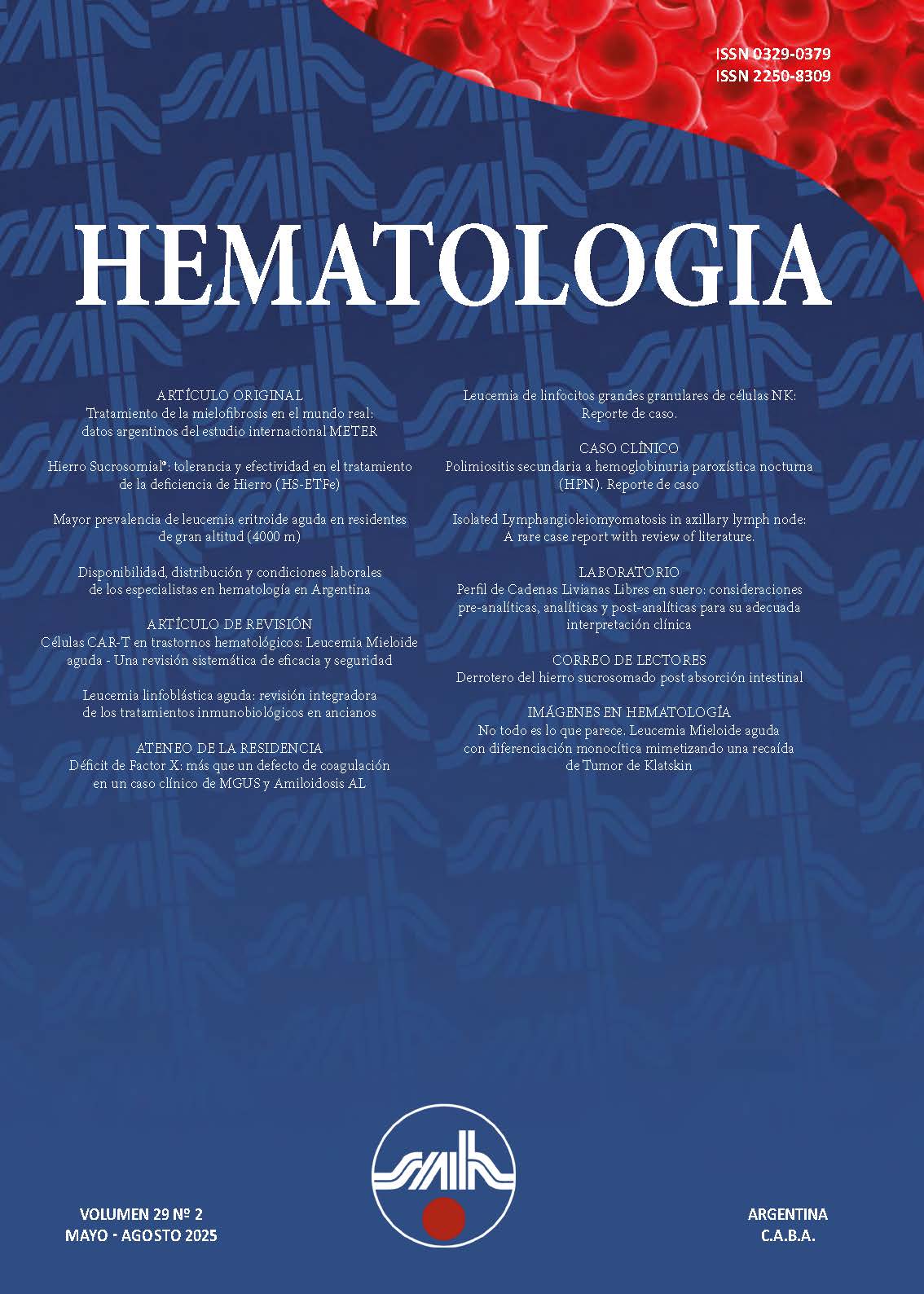Abstract
Introduction. Despite its importance, there is limited data regarding the hematology workforce in terms of the number and distribution of professionals, as well as their working conditions. The objectives of this study were to describe the density of hematology specialists in Argentina and to assess their professional and employment conditions. Materials and methods. To assess the availability and geographic distribution of hematology specialists, publicly accessible data from the Federal Observatory of Human Resources in Health were examined. Specialist-to-population ratios per 10,000 inhabitants were calculated at both national and provincial levels, with adult and pediatric hematologists analyzed separately. Additionally, data on profesional and employment conditions were collected through a survey disseminated by the Argentine Society of Hematology to all its members via institutional email on September 7, 2023 Results. The most recent available data on the number of hematology specialists corresponded to the year 2020. That year, Argentina had 1,095 adult hematologists, with a national rate of 0.35 per 10,000 adults. Striking interprovincial disparities were observed: the Autonomous City of Buenos Aires (CABA) had five times more hematologists per 10,000 inhabitants than the provinces of Córdoba and Buenos Aires, and 27 times more than Formosa and Catamarca. Regarding pediatric hematology, in 2020 there were 92 registered pediatric hematologists (rate: 0.06/10,000 inhabitants under 19 years of age) and 21 pediatric onco-hematology specialists (rate: 0.02/10,000). With respect to working conditions, 217 hematologists completed the survey. Among them, 69% were women, and the median age was 46 years (IQR 40–56). A total of 62.5% reported holding multiple jobs, 53% were employed under formal contracts, and 40% worked more than 40 hours per week. Additionally, 90% reported receiving no financial incentives from their institutions to encourage better performance. Conclusions. There are significant interprovincial disparities in the distribution of hematology specialists in Argentina. Furthermore, there is no evidence of an oversupply of professionals in this field. An accelerated process of labor precarization is underway, characterized by high levels of multiple employment, long working hours, and a low proportion of formally employed professionals.
References
Tobar F, Olaviaga S y Solano R. Complejidad y fragmentación: las mayores enfermedades del sistema sanitario. Versión agosto de 2012. DPP 108. 2012. Data fmed.
Maceira D, Palacios A, Urrutia M, Espinóla N, Nievas M. Descentralización y estructura de las remuneraciones médicas en Argentina: un análisis comparado en cinco jurisdicciones. Rev Argent. Salud Pública. 2017;8:26-32.
Cómo atraer, captar y retener al personal de salud en zonas rurales, remotas y desatendidas. Una revisión rápida (2022). OPS. Data en https://sirdoc.ccyl.es/Biblioteca/Dosieres/DL202PuestosSanitarios/pdfs/TextosInternacionales-OMS-OPS
OFETHUS. Ministerio de Salud de la Argentina. Data en https://www.argentina.gob.ar/salud/observatorio/mapa#3
REFEPS. Red Federal de Registros de Profesionales de la Salud. Data https://sisa.msal.gov.ar/sisadoc/docs/050102/refeps_home.jsp
RENAPER. Registro Nacional de las Personas. Data en https://www.argentina.gob.ar/interior/renaper
Economic, social and business data on the European countries. Data en https://www.europeinnumbers.com/rankings/hematologists/
Barber Pérez P, Gonzalez López-Valcarcel B. Informe Oferta-Necesidad de Especialistas Médicos 2021- 2035. EcoSalud. Universidad de Las Palmas de Gran Canaria 2022. Data en https://www.sanidad.gob.es/areas/profesionesSanitarias/profesiones/necesidadEspecialistas/home.htm
Organización Panamericana de la Salud. Estrategia de recursos humanos para el acceso universal a la salud y la cobertura universal de salud [Internet]. 29.ª Conferencia Panamericana de la OPS, 69.ª sesión del Comité Regional de la OMS para las Américas; del 25 al 29 de septiembre del 2017; Washington, DC. Washington, DC: OPS; 2017 (documento CSP29/10) [consultado el 5 de mayo del 2018]. Disponible en: https://www.paho.org/hq/index.php?option=com_docman&task=doc_download&gid=41533&Itemid=270&lang=es.
SEPEN, Katholieke Universiteit Leuven, Semmelweis University Budapest, Kovács E, Szegner P, Langner L et al. 2021. Mapping of National Health Workforce Planning and Policies in the EU-28: Final Study Report. LU: Publications Office of the European Union.
Navarro Pérez P, Contreras Sánchez A, Junco Gómez M, Sánchez Villegas P, Sánchez-Cantalejo Garrido C, Luque Martin N. Análisis de la distribución geográfica de médicos especialistas en la República Argentina. Buenos Aires; Ministerio de Salud de la Nación; 2015.Data en https://pesquisa.bvsalud.org/portal/resource/pt/biblio-884869?lang=es
Ministerio de Trabajo, Empleo y Seguridad Social. Situación ocupacional de los trabajadores de la rama salud. 2021. Data en https://www.argentina.gob.ar/sites/default/files/2021-10-06-informe_sobre_el_mercado_de_trabajo_del_sector_salud.pdf
All material published in the journal HEMATOLOGÍA (electronic and print version) is transferred to the Argentinean Society of Hematology. In accordance with the copyright Act (Act 11 723), a copyright transfer form will be sent to the authors of approved works, which has to be signed by all the authors before its publication. Authors should keep a copy of the original since the journal is not responsible for damages or losses of the material that was submitted. Authors should send an electronic version to the email: revista@sah.org.ar





